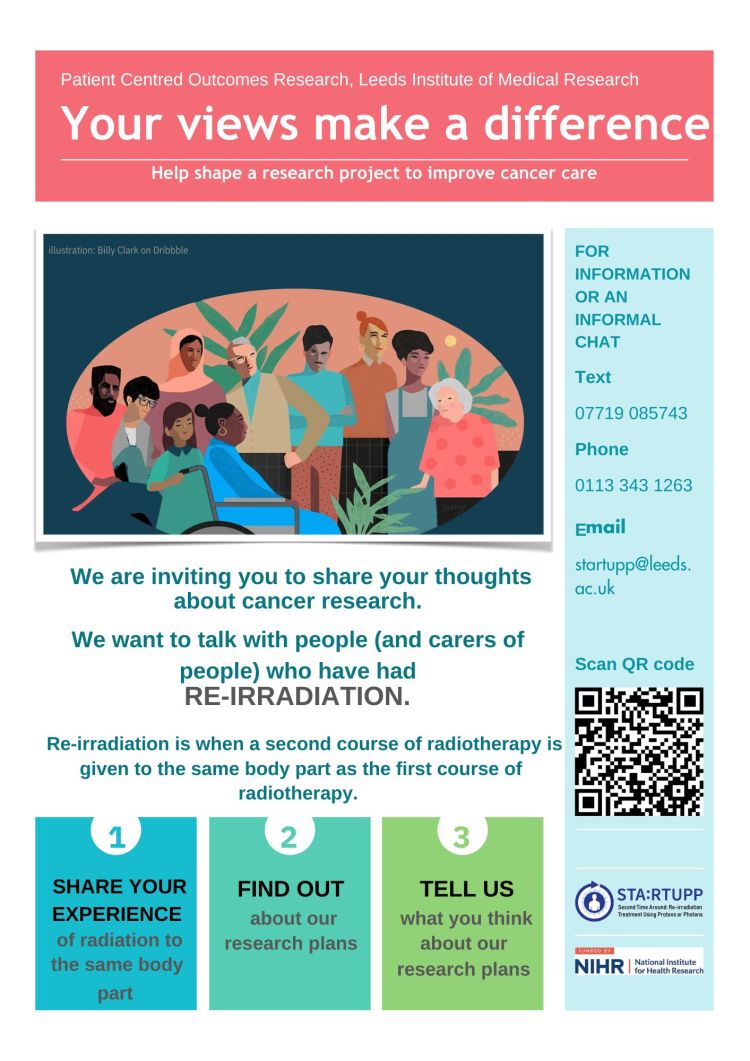Research project
STA:RTUPP: Second Time Around: Re-irradiation Treatment Using Photons or Protons.
- Start date: 1 January 2025
- End date: 31 December 2025
- Funder: National Institute for Health and Care Research (NIHR)
- Value: £149,352.18
- Partners and collaborators: Leeds Teaching Hospitals NHS Trust
- Primary investigator: Dr Louise Murray
- Co-investigators: Dr Fin Slevin, Dr Ane Appelt, Dr Florien Boele, Dr Katie Spencer, Alexandra Smith, Alexandra Smith, Sarah Brown
- External co-investigators: Mr Richard Stephens

Description


This is a research study that looks at patient and carer views about re-irradiation. Re-irradiation is a second course of radiotherapy in an area of the body that has already received radiotherapy, usually years or sometimes months before. We sometimes offer it to patients whose cancer has returned following previous radiotherapy. In some patients, re-irradiation may cure the cancer, but in others, re-irradiation could delay the need for other treatments such as chemotherapy or surgery. There is also a higher risk of serious side-effects from re-irradiation compared to a first course of radiotherapy. A newer type of radiotherapy, called Proton Beam Therapy (PBT), might be a better way to give re-irradiation to some patients than standard radiotherapy, because it can reduce the amount of radiotherapy given to the normal tissues surrounding the cancer. At the moment the use of re-irradiation varies widely across the UK and not all patients who might benefit are offered it. Also, the possible benefits of PBT for re-irradiation have not been investigated. We are planning a large re-irradiation research project, which will include a clinical trial to investigate PBT re-irradiation. This would ultimately improve patient access to re-irradiation and ensure patients receive high-quality re-irradiation, including PBT re-irradiation, if appropriate for their situation. Before we do this, we need to have more information to confirm if the larger research project is worthwhile.
We need to:
- Find out the number of patients who receive re-irradiation across the UK and find out how many patients might benefit if re-irradiation were more widely available.
- Understand more about how patients and carers feel about:
- Re-irradiation as a treatment
- Whether trials of re-irradiation are of interest.
- Whether PBT re-irradiation would be acceptable (as PBT requires more patients to travel further or temporarily relocate for treatment).
- Find out how patients and carers would like to be involved in designing and delivering the larger research project.
- Find out more about doctors and NHS decision-makers attitudes to re-irradiation, including how PBT might influence their views.
- Put together a team of patients, carers, doctors, radiotherapy experts and clinical trial experts who will help design and look at the results of the above activities and contribute to the larger research project.
- Put together a team of radiotherapy scientists who will design the re-irradiation treatments in the larger research project and find the radiotherapy information that they need to do this.
We will achieve this by:
- Using existing NHS radiotherapy data.
- Patient and carer interviews and focus groups.
- Doctor and decision-maker surveys and interviews.
- Inviting appropriate people to be part of teams (e.g., scientists and expert patients) and holding regular virtual and in-person meetings.
The work will guide the larger research project, to try to improve re-irradiation for patients.
We would love to talk with people (and carers of people) who have had re-irradiation treatment for cancer. If you are interested, please leave us your contact details here and we will be in touch.

https://pcor.org.uk/
https://ctru.leeds.ac.uk/
https://www.fundingawards.nihr.ac.uk/award/NIHR206942
https://medicinehealth.leeds.ac.uk/dir-record/research-groups/956/the-radiotherapy-research-group
Impact
This work will shape a Programme Grant application, which will include a multi-disease site clinical trial that investigates the role of PBT for re-irradiation. Ultimately this work will facilitate high-quality re-irradiation for NHS patients.

